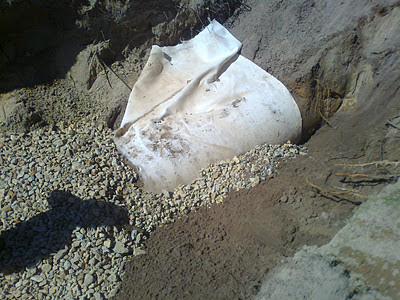Well the week kicked off last Sunday following the Men's Foursomes Championships with the River greens renovations starting with the greens scarifying. 8 greens were finished on Sunday afternoon which was a great effort. On Monday we started hollow tyning the greens and this time used a "mini tyne" which was 7mm in diameter compared to the normal 16mm tyne. This meant a smaller hole but more of them as can be seen in the video. The material was left on the green then rubbed in to the surface which left the "stubble" to be blown off. Fertiliser and amendments were then added and only a handful of greens required sanding to fill the aeration holes. It is hoped that this method which is quicker than the normal method will allow for a much faster recovery time. If the weather had stayed fine on Friday the greens would have received their first mowing then as they need to be dry to mow the first time. The weather also has to be on our side when doing the renovation this way as you need fine sunny and windy conditions to dry the cores out enough to allow them to be rubbed in.
 |
| Cores being rubbed in to the greens surface |
 |
| "Stubble" left on green |
 |
Blowing stubble off the green
|
We were able to then take advantage of the weather conditions to get the tees on the River course hollow tyne aerated and rubbed back in using a similar method to the greens but with the 16mm tynes. A hint of some rain on the way on Tuesday allowed 6 tonne of fertiliser to be applied to all the River course fairways which wasn't actually planned but if rainfall is on the way then you take advantage of it.
Next on the agenda was some work on the 8th River fairway drain. The 900mm pipe that connects the dam and the river has had several areas of subsidence over the years. About ten years ago we excavated and exposed the pipe and placed some material on it to prevent the subsidence which worked quite well until the material disintegrated after contacting the salt water and needless to say this material is no longer recommended for this purpose. The pipe was exposed and two causes of the subsidence emerged which was the separation of the pipes and the exposure of the pipe lifting hole, which both allowed sand to enter the pipe and erode the surface. The pipe was fully excavated and a geotextile fabric was wrapped around it then crushed rock placed over the top of this. Another fabric was then placed over the rock and the hole back filled ready for re-turfing. By blocking off the escape points for the sand it is hoped that the surface will hold. If it doesn't then the pipe will need to be replaced at a great expense.
 |
| Excavation begins |
 |
| Pipe separation |
 |
| Lifting hole exposed |
 |
| Cloth covering holes with crushed rock on top |
 |
| Fabric in place over crushed rock and sand over the top |
The rocks at the headwall of the dam at 6 River were then also replaced with much larger rocks and a far more suitable construction method to deal with the tidal movement of the water. Concrete was poured behind the rocks for added strength and smaller rocks embedded in to the concrete that over time will color up the same as the rocks so as to blend in.
 |
| Headwall reconstruction |
 |
| Large rocks in place. Note the tidal water flowing in. |
 |
| Small rocks embedded in concrete |
Then it was over to the 11th River tee to excavate the rear portion of the tee where tree roots had appeared on the surface. The picture below was the first load removed from the middle of the surface of the men's back tee blocks.
 |
| Tree roots from 11 River tee |
On Friday the oversown tees were lifted in readiness for turfing on Monday. It takes a day to prep these areas and the reason they are prepared on Friday is to allow the turf to be laid on Monday which means that by the following week end the turf will have taken root and not require any supplementary watering which saves on labour costs. The tees will be back in full play within 3 weeks. The material lifted from the tees has been used to cover exposed tree root in rough areas and although the finished surface is initially quite rough it does settle down and is far better than playing from amongst tree roots.
So that was my week in conjunction with maintaining and preparing the playing surfaces elsewhere on the course in the high winds and rainfall that occurred later in the week. Just another seven days in the life of a Golf Course Superintendent !!
















